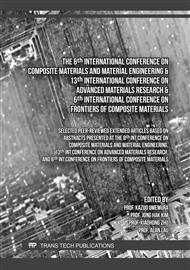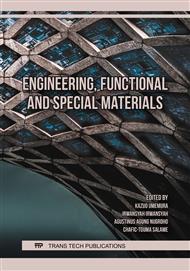[1]
Moayed, R.Z., E. Izadi, and S. Heidari, Stabilization of saline silty sand using lime and micro silica. Journal of Central South University, 2012. 19(10): pp.3006-3011.
DOI: 10.1007/s11771-012-1370-1
Google Scholar
[2]
Yang, B., et al., Pavement damage behaviour of urban roads in seasonally frozen saline ground regions. Cold Regions Science and Technology, 2020. 174.
DOI: 10.1016/j.coldregions.2020.103035
Google Scholar
[3]
Xing, G., et al., Influence of Alkaline Activators on Unconfined Compressive Strength of Saline Soils Stabilised with Ground Granulated Blast Furnace Slags. Advances in Civil Engineering, 2021. 2021: pp.1-13.
DOI: 10.1155/2021/8893106
Google Scholar
[4]
Ziaie-Moayed, R., M. Samimifar, and M. Kamalzare, Improvement of shear strength characteristics of saline soil using cement and polymer. International Journal of Geotechnical Engineering, 2013. 5(3): pp.307-314.
DOI: 10.3328/ijge.2011.05.03.307-314
Google Scholar
[5]
Puppala, A.J., N. Intharasombat, and R.K. Vempati, Experimental Studies on Ettringite-Induced Heaving in Soils. Journal of Geotechnical and Geoenvironmental Engineering@ASCE, 2005: pp.325-337.
DOI: 10.1061/(asce)1090-0241(2005)131:3(325)
Google Scholar
[6]
Firoozi, A.A., et al., Fundamentals of soil stabilization. International Journal of Geo-Engineering, 2017. 8(1).
Google Scholar
[7]
Kampala, A., et al., An investigation of sulfate effects on compaction characteristics and strength development of cement-treated sulfate bearing clay subgrade. Road Materials and Pavement Design, 2020. 22(10): pp.2396-2409.
DOI: 10.1080/14680629.2020.1753564
Google Scholar
[8]
Syed, M., A. GuhaRay, and D. Goel, Strength characterisation of fiber reinforced expansive subgrade soil stabilized with alkali activated binder. Road Materials and Pavement Design, 2021. 23(5): pp.1037-1060.
DOI: 10.1080/14680629.2020.1869062
Google Scholar
[9]
Goodarzi, A.R. and M. Salimi, Stabilization treatment of a dispersive clayey soil using granulated blast furnace slag and basic oxygen furnace slag. Applied Clay Science, 2015. 108: pp.61-69.
DOI: 10.1016/j.clay.2015.02.024
Google Scholar
[10]
Salimi, M., M. Ilkhani, and A.H. Vakili, Stabilization treatment of Na-montmorillonite with binary mixtures of lime and steelmaking slag. International Journal of Geotechnical Engineering, 2018. 14(3): pp.295-301.
DOI: 10.1080/19386362.2018.1439294
Google Scholar
[11]
D4318-17, A.S.f.t.a.m.A., Standard Test Methods for Liquid Limit, Plastic Limit, and Plasticity Index of Soils. 2018, ASTM International.
Google Scholar
[12]
D854-14, A.S.f.t.a.m.A., Standard Test Methods for Specific Gravity of Soil Solids by Water Pycnometer. 2014, ASTM International.
Google Scholar
[13]
D698-12, A.S.f.t.a.m.A., Standard Test Methods for Laboratory Compaction Characteristics of Soil Using Standard Effort (12,400 ft lbf/ft3 (600 kN-m/m3)). 2015, ASTM International.
DOI: 10.1520/d0698-07e01
Google Scholar
[14]
Tex-121-E, Tex-121-E_Soil-Lime Testing Eades_Grim Test. 2002, TxDOT DESIGNATION.
Google Scholar
[15]
D2166/D2166M-16, A.S.f.t.a.m.A., Standard Test Method for Unconfined Compressive Strength of Cohesive Soil. 2016, ASTM International.
Google Scholar
[16]
Ren, J., et al., The damage mechanism and failure prediction of concrete under wetting–drying cycles with sodium sulfate solution. Construction and Building Materials, 2020. 264.
DOI: 10.1016/j.conbuildmat.2020.120525
Google Scholar
[17]
Santos, F., et al., Geotechnical Properties of Fly Ash and Soil Mixtures for Use in Highway embankments. World of Coal Ash (WOCA) Conference, Denver, CO, USA, 2011: pp.125-136.
Google Scholar
[18]
Liu, Y., et al., Experimental investigation of the geotechnical properties and microstructure of lime-stabilized saline soils under freeze-thaw cycling. Cold Regions Science and Technology, 2019. 161: pp.32-42.
DOI: 10.1016/j.coldregions.2019.03.003
Google Scholar
[19]
Zhu, Y., et al., Unconfined Compressive Strength of Aqueous Polymer-Modified Saline Soil. International Journal of Polymer Science, 2019. 2019: pp.1-11.
DOI: 10.1155/2019/9137069
Google Scholar
[20]
Mboya, H.A., et al., Measurement of Pozzolanic Activity Index of Scoria, Pumice, and Rice Husk Ash as Potential Supplementary Cementitious Materials for Portland Cement. Advances in Civil Engineering, 2017. 2017: pp.1-13.
DOI: 10.1155/2017/6952645
Google Scholar
[21]
Shon, C.-S., Y.s. Jung, and D. Saylak, Evaluation of synthetic aggregates using off-ASTM specification ashes as road base course materials. Construction and Building Materials, 2013. 38: pp.508-514.
DOI: 10.1016/j.conbuildmat.2012.08.014
Google Scholar
[22]
Shon, C.-S., et al., Characterization of Mellowing Process to Control Expansion in High-Sulfate-Bearing Soil. Transportation Research Record: Journal of the Transportation Research Board, 2021. 2676(1): pp.355-364.
DOI: 10.1177/03611981211036345
Google Scholar



